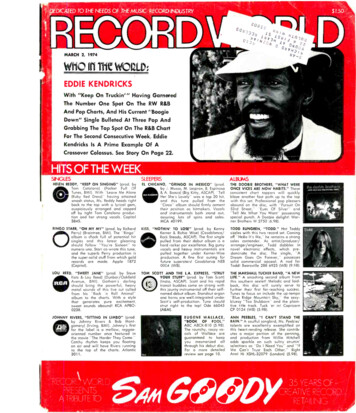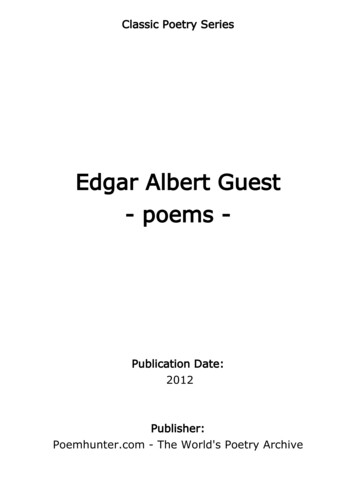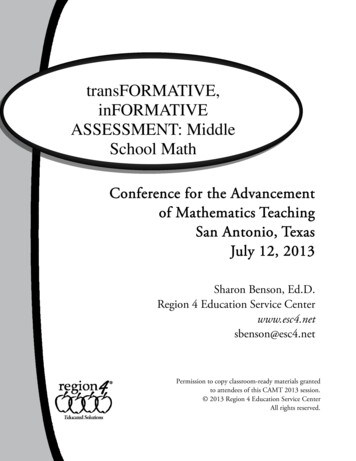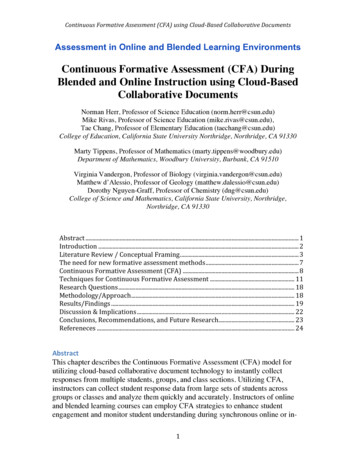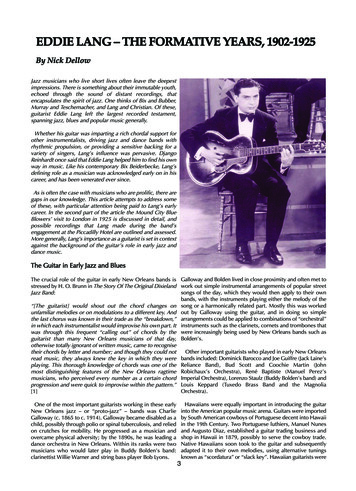
Transcription
167 Eddie Lang Part One Layout 1 05/09/2013 12:07 Page 1EDDIE LANG – THE FORMATIVE YEARS, 1902-1925By Nick DellowJazz musicians who live short lives often leave the deepestimpressions. There is something about their immutable youth,echoed through the sound of distant recordings, thatencapsulates the spirit of jazz. One thinks of Bix and Bubber,Murray and Teschemacher, and Lang and Christian. Of these,guitarist Eddie Lang left the largest recorded testament,spanning jazz, blues and popular music generally.Whether his guitar was imparting a rich chordal support forother instrumentalists, driving jazz and dance bands withrhythmic propulsion, or providing a sensitive backing for avariety of singers, Lang’s influence was pervasive. DjangoReinhardt once said that Eddie Lang helped him to find his ownway in music. Like his contemporary Bix Beiderbecke, Lang’sdefining role as a musician was acknowledged early on in hiscareer, and has been venerated ever since.As is often the case with musicians who are prolific, there aregaps in our knowledge. This article attempts to address someof these, with particular attention being paid to Lang’s earlycareer. In the second part of the article the Mound City BlueBlowers’ visit to London in 1925 is discussed in detail, andpossible recordings that Lang made during the band’sengagement at the Piccadilly Hotel are outlined and assessed.More generally, Lang’s importance as a guitarist is set in contextagainst the background of the guitar’s role in early jazz anddance music.The Guitar in Early Jazz and BluesThe crucial role of the guitar in early New Orleans bands is Galloway and Bolden lived in close proximity and often met tostressed by H. O. Brunn in The Story Of The Original Dixieland work out simple instrumental arrangements of popular streetsongs of the day, which they would then apply to their ownJazz Band:bands, with the instruments playing either the melody of the“[The guitarist] would shout out the chord changes on song or a harmonically related part. Mostly this was workedunfamiliar melodies or on modulations to a different key. And out by Galloway using the guitar, and in doing so simplethe last chorus was known in their trade as the “breakdown,” arrangements could be applied to combinations of “orchestral”in which each instrumentalist would improvise his own part. It instruments such as the clarinets, cornets and trombones thatwas through this frequent “calling out” of chords by the were increasingly being used by New Orleans bands such asguitarist than many New Orleans musicians of that day, Bolden’s.otherwise totally ignorant of written music, came to recogniseOther important guitarists who played in early New Orleanstheir chords by letter and number; and though they could notread music, they always knew the key in which they were bands included: Dominick Barocco and Joe Guiffre (Jack Laine’splaying. This thorough knowledge of chords was one of the Reliance Band), Bud Scott and Coochie Martin (Johnmost distinguishing features of the New Orleans ragtime Robichaux’s Orchestra), René Baptiste (Manuel Perez’smusicians, who perceived every number as a certain chord Imperial Orchestra), Lorenzo Staulz (Buddy Bolden’s band) andprogression and were quick to improvise within the pattern.” Louis Keppard (Tuxedo Brass Band and the MagnoliaOrchestra).[1]One of the most important guitarists working in these earlyNew Orleans jazz – or “proto-jazz” – bands was CharlieGalloway (c. 1865 to c. 1914). Galloway became disabled as achild, possibly through polio or spinal tuberculosis, and reliedon crutches for mobility. He progressed as a musician andovercame physical adversity; by the 1890s, he was leading adance orchestra in New Orleans. Within its ranks were twomusicians who would later play in Buddy Bolden’s band:clarinettist Willie Warner and string bass player Bob Lyons.Hawaiians were equally important in introducing the guitarinto the American popular music arena. Guitars were importedby South American cowboys of Portuguese decent into Hawaiiin the 19th Century. Two Portuguese luthiers, Manuel Nunesand Augusto Diaz, established a guitar trading business andshop in Hawaii in 1879, possibly to serve the cowboy trade.Native Hawaiians soon took to the guitar and subsequentlyadapted it to their own melodies, using alternative tuningsknown as “scordatura” or “slack key”. Hawaiian guitarists were3
167 Eddie Lang Part One Layout 1 05/09/2013 12:07 Page 2touring the West Coast of the USA by the late 19th Century.Hawaiian music – usually played on “Hawaiian” shaped guitarsusing a steel slide – became extremely popular during the FirstWorld War period and remained so throughout the 1920s and1930s. Amongst the Hawaiian steel guitarists of the 1920s and1930s who found fame in America were Sol Hoopii, JosephKekuku, Frank Ferera, Sam Ku West and “King” Bennie Nawahi.Eddie Lang - Early Life and InfluencesEddie Lang was born Salvatore Massaro on October 25th 1902in Philadelphia, to Dominic and Carmela Massaro, Italians fromMonteroduni, a small town about 110 miles south-east ofRome, who had emigrated to the USA in the 1880s. TheMassaro family settled in the Italian district of SouthPhiladelphia, and eventually raised nine children, of whomSalvatore was the youngest.The Hawaiian style of playing also crossed over into the bluesgenre, with several early blues guitarists adopting the slide In an article published in the September 1932 edition of theguitar. W. C. Handy, the “Father of the Blues”, recalled an British magazine Rhythm, Eddie Lang described his father as aencounter with a blues guitarist around the beginning of the “maker of guitars in the old country” [4]. The extent to which20th century:Dominic could apply his trade as a guitar maker in the NewWorld would have been curtailed by the fact that he did not“One night in Tutwiler, as I nodded in the railroad station while speak more than a few words of English. It has also beenwaiting for a train that had been delayed nine hours, life suggested that he was illiterate, something that would havesuddenly took me by the shoulder and awakened me with a been commonplace in the 1880s, not only amongst immigrantsstart.but the indigenous population too. According to the 1910A lean, loose-jointed Negro had commenced plunking a census, Dominic’s occupation was “labourer, railroad”. By theguitar beside me while I slept. His clothes were rags; his feet 1920 census, he had elevated his station in life to “railwaypeeped out of his shoes. His face had on it some of the sadness foreman”, suggesting that not only was he a reliable employeeof the ages. As he played, he pressed a knife on the strings of but also that both his written and spoken English hadthe guitar in a manner popularized by Hawaiian guitarists who progressed commensurately.used steel bars. The effect was unforgettable. His song, too,struck me instantly: “Goin’ where the Southern cross’ the As was the case with many Italian families, the MassaroDog”. The singer repeated the line three times, accompanying children began to play musical instruments at an early age:himself on the guitar with the weirdest music I had ever heard.”[2]“Most people start their musical education at an early age, andI, being no exception, started at the very tender age of one andDespite its crucial role in early New Orleans bands, the guitar a half years. My father was a maker of guitars in the old country,made few inroads into the mainstream dance band and jazz and he made me an instrument that consisted of a cigar boxscene that mushroomed in popularity after the First World War. with a broom handle attached, and strong thread was used asThough the Original Dixieland Jazz Band didn’t use a stringed the strings.” [4]instrument, the small white Dixieland bands that sprang up tocash in on the jazz craze the ODJB created often used a banjoWhen he was a few years older – probably seven or eightin their rhythm section in place of a piano, with the Frisco Jass years old – Salvatore was given a more conventional guitar,Band being the first such outfit to employ a banjo on recordings made by his father on a scale small enough for the youngest(for Edison in 1917). By the early 1920s, the banjo was more Massaro offspring to reach all the frets.or less ubiquitous in jazz/dance bands.Eddie Lang’s parent’s home was at 701 South Marshall Street,The situation is neatly summarised by David K. Bradford:Philadelphia, in the heart of the Italian district. The family livedhere until at some point (probably just after the First World War“By the time New Orleans style jazz bands began to be widely when Dominic was promoted) they moved to 738 St. Albansrecorded, the tenor banjo – which was louder and crisper Street, just round the corner. This is the address given for thesounding, and recorded better than the guitar on early family in the 1920 census. Giuseppe ‘Joe’ Venuti lived nearby,recording equipment – had replaced the guitar in many bands. on 8th Street, off Clymer Street.As a result, we have only a fairly small sample of what the guitarsounded like, and how it was played, in the earliest New Venuti and Lang were close in age - Eddie was 13 years oldOrleans ragtime and jazz bands, and then only from and Joe was 12 - and they both attended the local Jamescomparatively later recordings.” [3]Campbell School, where they were also both taught to play theviolin - the first instrument of choice for formal music training.Developments in the construction of banjos during this period Lang started on violin at 8 years old and continued until he leftreflected the predominance of the instrument in the popular school aged 15.music field. The instrument’s body and its resonator wereenhanced to increase the instrument’s volume so that it could The violin that Lang began his musical education on wasbe heard above the dominating brass and woodwind acquired through an unusual set of circumstances. At someinstruments of ever larger bands. Various models were point in his early childhood, Lang was involved in a seriousavailable, with the plectrum banjo finding preference in the accident. Columnist Ed Sullivan – later to find fame on televisionearly years, but the tenor banjo becoming increasingly popular – stated that he had been “Hit by a Philadelphia street car whenafter 1910, particularly following Irene and Vernon Castle’s he was a kid, and was forced to bed for a year, and with theintroduction of the Tango in the USA in 1913.money his family received, they bought him a violin”.[6] Langsuffered from sporadic periods of illness throughout his life,most of which seem to concern his digestive system. Accordingto Jack Bland, the banjoist of the Mound City Blue Blowers,4
167 Eddie Lang Part One Layout 1 05/09/2013 12:07 Page 3Lang “didn’t like to drink because he had a bad stomach andwas afraid he’d get ulcers”.[7] It has not been possible to verifyif this poor health arose as a direct result of the accident hesuffered as a child. Lang’s medical records were unfortunatelydestroyed in a fire.[8]James Campbell School had two outstanding professors ofmusic: Professor Ciancarullo, with whom Lang studied for threeyears (Ciancarullo had previously played with the NaplesSymphony Orchestra), followed by tuition under ProfessorLuccantonio. Under their tutelage, Lang was given a thoroughgrounding in music, including theory and harmony. This formalmusical education also introduced him to European classicalcomposers: Lang developed a particular fondness for Debussyand Ravel. It is said that he also attended the Settlement MusicSchool in Philadelphia, but it is not known if the lessons he hadhere were for violin or guitar. In fact, whether he had any formallessons on the guitar is difficult to ascertain. Lang himself statedthat he “fooled around with a guitar at home”, [3] indicatingthat he was self-taught, while other sources suggest that he mayhave had lessons from at least one or possibly two uncles whowere guitar players. If his father was a guitar maker, as Langstates, then it is likely that he gave his son lessons. Moreover,within the close-knit Italian neighbourhood that Lang grew upin, there would have been other experienced guitarists whocould have taught him.under which you don’t bother much about any specialinstrument until you know all the fundamentals of music. It’sthe only way to learn music right. Later, when I started to studyfiddle seriously, I had several good teachers.” [5]The informal way the guitar was taught at the time wouldhave emphasised its role as an accompanying instrument,whereby mostly bass notes on the main beat would be followedby chords on the weak beats interspersed with occasional bassruns. This technique was not only applied to vocalaccompaniments but also in marches, waltzes, tangos.andblues and jazz.Venuti and Lang practiced together and a musical camaraderiesoon developed, as Venuti recalled:“Eddie and I were kids in the same neighbourhood inPhiladelphia. We went through grammar school and highschool together. We used to play a lot of mazurkas and polkas.Just for fun we started to play them in four-four. I guess we justliked the rhythm of the guitar. Then we started to slip in someimprovised passages. I’d slip something in and Eddie wouldpick it up with a variation. Then I’d come back with a variation.We’d just sit there and knock each other out.” [5]Venuti also stated that their practice sessions wouldsometimes last up to 10 hours a day, and they would oftenThe manner in which Italian children were taught music was exchange instruments to further hone their skills. Later on,emphasised by Joe Venuti:when appearing in vaudeville, Lang and Venuti would alsosometimes swap instruments, with Lang playing violin and“Formal training? I think a cousin started to teach me when I Venuti playing guitar or mandolin!was about four. Solfeggio, of course. That’s the Italian systemThe fact that Lang received over a decade of tuition underwell respected professors of music should dispel any notionsthat he was a poor reader. However, throughout his career Langoften “busked” his way through a number, relying on hisnaturally musical ear to navigate his way through the chordprogressions. The fact that his innate musical skills were finetuned by years of theory and harmony training seemed tonegate the notion held by other musicians that Lang was somesort of musical genius, and so his formal tuition was rarelyconsidered part of the magic formula.A typical reaction concerning Lang’s skills is that expressedby Paul Whiteman. Lang was a member of Whiteman’sgargantuan band of top musicians in 1929-1930, during andjust after the making of The King Of Jazz, in which Lang isbriefly seen playing together with Joe Venuti. Whiteman laterreminisced:“To my mind Lang was one of the greatest musical geniuses weever had in the band. I never saw him look at a note of music.I don’t even know whether he could read or not. It made nodifference. What’s the use of bothering with those pesky blackblotches when you can anticipate the next chord change fivebars in advance? No matter how intricate the arrangement was,Eddie played it flawlessly the first time without having heard itbefore, and without looking at a sheet of music. It was if hismusically intuitive spirit had read the arranger’s mind, andknew in advance everything that was going to happen.” [9]James Campbell School in Philadelphia, where both Eddie Lang andJoe Venuti were pupils. Photo courtesy Ray Mitchell.Even Joe Venuti, who knew better, was not averse toperpetuating the myth that Lang didn’t read music:“I’ll tell you something you haven’t heard before. Eddie Lang6
167 Eddie Lang Part One Layout 1 05/09/2013 12:07 Page 4didn’t read a note of music. He could hear it so what was thepoint of writing it for him. He had a great ear. When he used toplay something intricate, people who used to know that he wasjust a “faker” used to bet he could not do it again. But heremembered every note he ever played. If he played a greatthing once he knew it. And he was a brilliant rhythm man.” [10]Although Venuti and Lang played together in bands inPhiladelphia before Lang joined the Mound City Blue Blowers,their most productive, and certainly best known, musicalassociation belongs to the period after Lang’s return fromLondon in June 1925 as is therefore outside the scope of thisarticle.Salvatore Massaro adopted the name ‘Eddie Lang’ as ateenager, after a popular basketball player in the local SouthPhiladelphia Hebrew Association league, a sportsman who hadalmost certainly changed his own name from that given to himat birth. This Anglicisation of names was especially commonwith the children of immigrants, who often spoke English astheir first language and usually had a greater desire than theirparents to acculturate within the host country’s mainstreamsociety. Eddie’s older brother Alexander was more often knownas Thomas or Tom (he appears on the 1920 census as Thomas,with no mention of Alexander), and a sister – Magdelena – wasknown as Eadie. Incidentally, both Tom and Eadie were guitarplayers, though they did not achieve anything remotely like thesuccess of their more illustrious brother. Alexander’s passportgives his occupation as “chauffeur”, and the 1920 census listshim as a ‘factory worker’, which indicates that he was an oddjob man, willing to take on work wherever he could find it.Eadie apparently worked during the 1930s as a guitarist, butthere are no further details.venues were a feature of the bustling, lively South Street inSouth Philadelphia. This was a cosmopolitan environment, withfew venues having colour bars, where black and whiteperformers were often within earshot of each other, affordingthe opportunity for musicians to pick up new ideas from eachother.South Street is nowadays known for its bohemian atmosphere– especially in the stretch between Front Street and SeventhStreet – but it was traditionally a middle class thoroughfare,dominated by fashionable tailors’ shops. The atmospherestarted to change in the late 19th century as theatres and barsbegan to open up along the street. Amongst these were blackowned theatres, most notably the Standard and the Dunbar.Founded in 1914, the Standard was the more famous of thetwo, reaching its peak during the 1920s but subsequently fallingvictim to the economic crash, closing in 1931. The theatre wasowned and managed by the influential and charismatic John T.Gibson, a black entrepreneur who had tapped into theburgeoning market for black vaudeville acts. The venues heowned in Philadelphia became an important part of the TOBAcircuit. Playing the New York, Philadelphia, Baltimore andWashington (DC) circuit was known as “going around theworld” by black entertainers.Lang lived just a few blocks from South Street, and it was toSouth Street that both he and Venuti would go to hear blackperformers playing and singing. The inspiration derived fromsuch experiences can be heard in Lang’s blues playing,particularly in his bending of single strings to create “bluenotes”.Amongst the black blues players who lived in Philadelphiaand plied their trade along South Street was guitarist BobbyLeecan. Leecan is listed in both the 1920 and 1930 census asliving at his parent’s house at 7239 Paschall Avenue,Philadelphia (in the 1920 census he is listed as a “piano player– odd jobs”!).Growing up in Philadelphia, Lang was exposed to a widevariety of folk music. Beyond the Italian folk songs that wouldhave been ever-present, there were other sounds that theyoung Lang would have encountered. Philadelphia played hostto a variety of immigrant communities, each importing theirown indigenous folk music: amongst these were Poles,What Leecan sounded like in the early 1920s we cannot beGermans, Irish and Jews.certain, since he did not record until later in the decade, but acomparison of the blues recordings Leecan made with those ofAdded to this rich source of folk music was blues and jazz. Lang reveals some stylistic similarities. For example, Leecan’sThe city had the largest African-American population north of guitar playing in the ensemble passages on Fats Waller/Thomasthe Mason-Dixon line, and was one of the most important cities Morris’ Red Hot Dan (Victor 21127) features single stringin the Northern states for both visiting and itinerant blues and counter melodies intermingled with strumming chords and anjazz musicians and singers. It even had its own black symphony overall blues feeling. Another typical example of Leecan’s workorchestra. A number of African-American-owned entertainment is his guitar backing to Margaret Johnson’s vocal on SecondHanded Blues (Victor 20652). Compare this, for instance, withLang’s guitar on Doin’ Things (OKeh 40825) by Joe Venuti’sBlue Four.It is quite possible that Lang heard Leecan in Pennsylvania inthe early 1920s. At the very least, Leecan’s recordings provideevidence, albeit circumstantial, that black blues players whoperformed in Philadelphia were a source of inspiration for theyoung Eddie Lang, who displayed an empathy for the bluesbeyond that of most of his white contemporaries of the time.Charlie Kerr & His L’Aiglon Orchestra, 1923. L-R: Joseph DeLuca(tb), Leo McConville (t), Mike Trafficante (bb), Albert Valante (vln),Bob McCracken (p), Eddie Lang (bj/g), two saxophonists - JerryDeMasi (sax), Vincenzo D'Imperio (sax) - but unsure which is which,Charlie Kerr (ldr, d). Photo courtesy of Enrico Borsetti via theBixography Forum.Lang’s natural ability to assimilate different types of musicand weave them into his own unique style, creating somethinghighly original in the process, was similar in approach to thatof Bix Beiderbecke, and in this respect it is no coincidence thatthey both had absolute perfect pitch. Jack Bland, the banjoistin the Mound City Blue Blowers, remembered Lang’s7
167 Eddie Lang Part One Layout 1 05/09/2013 12:07 Page 5phenomenal ear: “He had the best ear of any musician I everknew. He used to go into another room and hit an “A” andcome back and play cards for fifteen minutes, and then tunehis instrument perfectly. I’ve seen that happen.” [7] Thisexercise would have presented no problem for Bix either.Incidentally, like Lang, Bix was also a superb card player!Early Professional WorkEddie Lang’s first paid job was in 1918, as a banjoist in a banddirected by local drummer Chick Granese, in which 15 yearold Venuti was already a member. The outfit played at Shott’sCafe at 12th and Filbert Streets, Philadelphia. Though Lang washired as a banjoist, within a few weeks he was also beingfeatured on guitar. This job was followed by short term datesat various bars and cafes in Philadelphia around 1919 and early1920, which provided the young guitarist with plenty ofopportunities to absorb the disparate musical styles thatemanated from such venues.ragtime, framed their concepts of jazz. Eddie’s single stringvirtuosity pointed in a new direction.” [11]In mid-1923, after making his recording debut with Kerr’s bandfor Edison, Lang left to join the vaudeville team of Frank Fay andBarbara Stanwyck (the latter was later to find fame inHollywood) in New York, but soon returned to Philadelphiabecause of illness, presumably the digestive system conditionthat he had suffered from since his childhood accident.After a few weeks, Lang recovered from his bout of illnessand returned to New York, joining trumpeter Vic D’Ippolito’sband at the Danceland ballroom. The band folded after a finalperformance on New Year’s Eve, 1923. D’Ippolito joined TedWeems’ band for six months and Lang joined the ScrantonSirens, a local band through which many dance band and jazzluminaries passed, including the Dorsey Brothers, BillyButterfield, Bill Challis and Russ Morgan. When Lang joined,the band was directed by Billy Lustig and known as “Billy Lustigand his Sirens Orchestra”. On New Year’s Day 1924, the bandopened at the Beaux Arts Café in Atlantic City for a two-weekengagement, subsequently touring a series of one-nighters. BillyLustig and his Sirens then returned to Atlantic City and openedat the Cafe Follies Bergere on June 24th, 1924.In 1920, Lang moved up in the local dance band world, joiningCharlie Kerr’s Orchestra, one of Philadelphia’s top bands of thetime, playing at Al White’s Dance Hall at 10th and MarketStreets and later, in 1921, at the Café L’Aiglon. Lang stated thathe joined the band as a violinist, [4] but soon doubled on banjoand guitar. He was already gaining a reputation as a banjoist Appearing in Atlantic City at the same time, at the nearbyand guitarist, to the point of being specially featured in “stop Beaux Arts Café, were the Mound City Blue Blowers, a noveltychoruses” on banjo that demonstrated his prowess. As Richard band featuring a kazoo, paper-and-comb and banjo, and ridinghigh on the success of their Brunswick records. One evening,DuPage noted:late into the night, the Mound City Blue Blowers were jamming“This type of solo was a departure from the traditional away, when Lang walked in and asked to join in. As Richardrapidamente thrumping of triplets and syncopated full chords Hadlock noted:in which banjoists, influenced by pre-war minstrel shows andBilly Lustig and his Sirens Orchestra (left to right): Sid Trucker (cl, ts), Billy Lustig (vln, ldr), Ted Noyes (d), Irving "Itzy" Riskin (p), RussMorgan (tb), Vic D'Ippolito (t), Eddie Lang (g), Alfie Evans (as), Mike Trafficante (bb). Photo courtesy Josh Duffee via the Bixography Forum.8
167 Eddie Lang Part One Layout 1 05/09/2013 12:07 Page 6Courtesy Joe Moore.“In casual jam sessions, the uncommon sound of Lang’s guitar World to wrap around his comb! It is also said that Slevinadded harmonic flesh and rhythmic bones to the rather rickety attempted to play paper and comb, but found that thesound of the little group.” [12]vibrations of the paper tickled his sensitive lips, and so he stuckto the kazoo. The novel trio would retire to Bland’s apartmentThe Mound City Blue Blowers would from then on visit the almost every evening with a bottle or two for informal jamCafe Follies Bergere regularly to listen to Lang play solos on sessions, as well as to rehearse the numbers they would laterbanjo and guitar. After a few days, the Mound City Blue record and/or perform in public.Blowers’ banjoist Dick Slevin walked up to Lang and offeredhim 200 a week to join the band. Lang initially turned the offer In the late 1930s, Red McKenzie reflected on how the banddown but with the encouragement of Lustig’s sidemen came into being:eventually accepted. He joined the Mound City Blue Blowersin New York in time for the band’s opening night at the Palace “I was a bellhop in the Claridge hotel [St Louis] and across theTheater. Lang’s stage rehearsal with the Mound City Blue street was a place called Butler Brothers’ Soda Shop. Dick SlevinBlowers in New York almost didn’t happen: turning up an hour worked there and there was a little colored shoe-shine boy whoor so late, Lang’s voice was heard from way up in the balcony used to beat it out on the shoes. Had a phonograph going. Iof the Palace Theater: “Hey, are you boys down there?” Lang passed with my comb, and played along. Slevin would havehad entered via the fire escape and lost his way through the liked to play a comb but he had a ticklish mouth, so he used akazoo. He got fired across the street and got a job in a big sodalabyrinth of back stage corridors! [7]store. He ran into Jack Bland, who owned a banjo, and onenight after work they went to his room. He and Slevin startedThe Mound City Blue Blowersplaying. They got me. Gene Rodemich’s was a famous band atThe Mound City Blue Blowers were formed in St. Louis in 1923 that time. His musicians used to drop in at the restaurant whereand initially consisted of Red McKenzie on paper and comb, we hung out. They were impressed and told their boss. He tookDick Slevin on kazoo and Jack Bland on banjo. By the Autumn us to Chicago to record with his band, as a novelty.When we got to Chicago we went down to the Friars’ Inn.of 1923, the trio felt sufficiently well rehearsed to play in public,and secured a job playing in-between sets at St. Louis’ Turner About 1924 it was. Volly de Faut and Elmer Schoebel werethere. Isham Jones was at the place and he asked us whatHall.instruments we were playing. He had us come to his office nextThe Mound City Blue Blowers traded on the novelty of their day, and set the date for Brunswick. That was the time we madeinstrumentation and this aspect was undoubtedly the key to “Arkansas Blues” and “Blue Blues”. They say it sold over atheir success. However, even through the hokum instruments million copies. Brunswick put us in a cafe in Atlantic City calledof Slevin’s kazoo and what McKenzie called his “hot comb” the Beaux Arts. I met Eddie Lang in Atlantic City. In New York,there was genuine feeling, especially when it came to The Mound City Blue Blowers played the Palace in August,1924.”interpreting the Blues.Eddie Condon later said, somewhat mischievously, that Red In the early 1940s, Jack Bland was interviewed by Art HodesMcKenzie only used strips of newspaper from the New York and recalled:10
167 Eddie Lang Part One Layout 1 05/09/2013 12:07 Page 7“I was working in a soda fountain in St. Louis and one day afellow came in and asked for a job. He got the job but wasn’tso good as a soda clerk. That night he went out with me to theplace where I was staying. I had a banjo; he saw it and enquiredif I could play it. I said yes, a little, so he pulled a ‘kazoo’ out ofhis pocket and we stomped off. It sounded pretty good, so thatnight we went to the Arcadia Dance Hall.banjo, kazoo andall.After the dance we took a couple of girls home; they lived inNorth St Louis. After leaving the girls we stopped at the WaterTower Restaurant and we ran into Red McKenzie. We sat thereand played until the owner ran us out of the place; then we gotonto the Grand Avenue street car with the whole gang and adonkey conductor
Django Reinhardt once said that Eddie Lang helped him to find his own way in music. Like his contemporary Bix Beiderbecke, Lang’s defining role as a musician was acknowledged early on in his . introduction of the Tango in the USA in 1913. Eddie Lang - Early Life and Influences E




